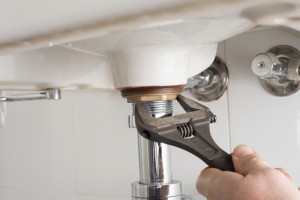
Every day in the United States, 14,000 people experience a water damage emergency at home or work. Prevent your property from being added to this costly statistic through early leak detection.
If you think you’ve sprung a leak, don’t procrastinate. Find the drip and fix it immediately.
Early Warning
An abnormally high water bill is a common sign that you could have a concealed leak in your home.
Confirm your assumption using your water meter:
- Check all faucets and water consuming appliances to make sure they are turned off.
- Mark the current reading on your water meter.
- Do not use any water for 2 hours.
- Check the meter again. If it registers water usage, you’ve got a leak.
You can now run a guess and check system throughout the house to try and pinpoint the location of the water flow.
Turn off the intake valve to each toilet, faucet and appliance one at a time until the water meter no longer shows a new flow. Once you think you’ve located the leak, turn that specific valve back on to confirm.
In the case that all valves are closed and you’re still registering usage, it’s likely your leak is due to pipe damage and is hidden within a wall or under the house.
The Most Common Culprit
A leaky toilet is perhaps the most common source of a hidden usage in the home. Always check toilets first when looking for a phantom leak.
- Once a toilet tank is full it should no longer make noise. Put your ear next to the tank and listen for water flow. Dry the sides of the bowl and wait to see if water flows down from the jets.
- If you confirm that water is flowing from the tank into the bowl check that the float valve is low enough that the water level is at least 1 inch below the overflow tube.
- Test the handle mechanism to ensure it is working smoothly. A sticky handle can leave the flapper elevated for water to flow into the bowl.
- If the toilet is silent but you still suspect it is leaking, squeeze a few drops of food coloring into the tank. If the coloring bleeds into the bowl, you’ve got a faulty flapper that needs to be replaced.
- Check the floor around the base and underneath the tank. Bad seals or loose tank bolts may also be behind your leak.
Faucets and Taps
Visually inspect all kitchen and bath fixtures for moisture around the base or underneath the sink. A small leak can be hard to spot as water can continuously flow along the outside of the pipe or wall without forming a full droplet to drip.
To confirm that a faucet is leaking, dry the base thoroughly with a paper towel and then return in 15 minutes to check again.
Appliances
Use a flashlight to inspect underneath your hot water heater. In general, a leaky water heater is easy to spot right away.
Appliances that are more likely to have a concealed leak include: furnace humidifier, water softener, ice maker, sprinkler system or swimming pool equipment.
